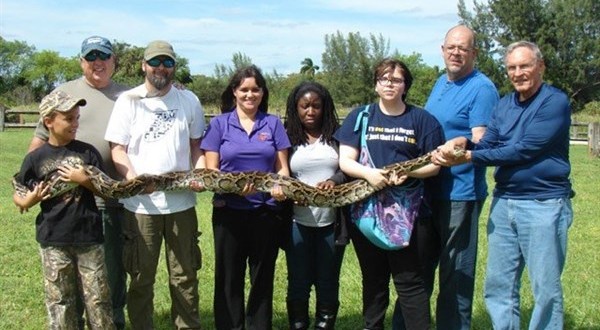The hunt is on for invasive Burmese pythons in Florida’s wetlands.
More than 400 people have registered so far for Florida’s second Python Challenge, hoping to win prizes and fleeting fame in the fight against the Burmese pythons that have infested the Everglades.
The snake-catching festival, which runs from Jan. 16 to Feb. 14, attempts to reduce South Florida’s population of the giant constrictors, refugees from the exotic pet trade that have established themselves among the top predators of the Everglades..
With its alluring combination of scary snakes, the Everglades and amateur python catchers — either intrepid or hapless, depending on your perspective — the event has drawn interest from national media, as well as from television networks in Japan, Germany and France. Ridiculed in some quarters as a publicity stunt that last time achieved remarkably little for the amount of time and effort involved, the Python Challenge is defended by officials with the Florida Fish and Wildlife Commission as a valuable exercise to draw attention to the damage being done by non-native species.
“The intent of the Python Challenge is to engage the public in environmental conservation and invasive species removal,” said spokeswoman Carli Segelson. “One of the goals is to make people aware of non-natives and how to report them.”
The previous challenge, held in 2013, resulted in the capture of 68 snakes. No one knows how many are out there, but estimates have ranged into the tens of thousands. They feed on rabbits, raccoons, alligators and other wildlife, reducing their numbers and competing with native predators.
Although most participants registered so far are from Florida, others will come from Texas, New York, Pennsylvania, Georgia, North Carolina, Massachusetts, Colorado, Connecticut, Ohio and Michigan. Among the people engaged in this scaly, swampy form of ecotourism will be Vincent Romanelli, a retired New York City police officer, who will drive down for the event from his home in suburban Philadelphia.
“It looks very interesting, and there’s a bit of excitement to it,” he said. “The environmental issue is very serious.”
He studied up on pythons and took the online training offered by the wildlife commission but realizes this will be a challenging hunt.
“I know they’re very elusive,” he said. “I read they only captured 68 snakes, and I read about how they’re camouflaged.”
Judging by the results of the 2013 challenge, the average participant’s chance of seeing a python — let alone catching one — is pretty close to zero.
About two thirds of the pythons were caught by trained snake experts. Just 14 of the 1,558 members of the general public who registered for the hunt caught snakes (some catching more than one), for a success rate of .9 percent.
The python’s tan, brown-blotched skin turned out to be excellent camouflage for South Florida, allowing the snakes to become practically invisible in the Everglades.
Aware of the difficulty of finding them, the state wildlife commission this year is offering Python Challenge participants more training and more areas are being opened up to the hunt. They include most of the Everglades, with the exception of Everglades National Park, which does not allow hunting, Big Cypress National Preserve, Fakahatchee Strand Preserve State Park, Collier-Seminole State Park and several wildlife management areas.
Participants will compete for individual and team prizes for catching the most pythons and catching the longest one. The pythons are either bagged and taken alive to a drop-off location, where they’re killed, or killed in place using a firearm or captive bolt.
The winner of the 2013 event — master snake-hunter Ruben Ramirez, a Miami reptile enthusiast who caught 18 snakes — won’t be participating this time around. He said he plans to attend the hunt to assist others, but not compete. And based on their performance last time, he said, the average would-be snake catcher can really use some help.
“In the 2013 one, there were a lot of people who came down here who didn’t know what a python was,” he said. “They came and thought they would be strolling around pythons. It truly does not work like that.”
He hopes to teach people how to read the land, looking for places such as rock ledges and rock piles, dry areas with cover that are close to wet areas, and other places more likely to harbor pythons. They need to be aware of the weather and the time of day to know which habitats the pythons are likely to favor, based on their need to maintain their body temperatures.
But he said it’s still a difficult business that can’t be taught in a few hours and expects most would-be hunters to come away with empty snake bags.
“The detection rate is like 1 percent,” he said. “You could step a foot away from a 15-foot python and you wouldn’t ever see it.”
How to register for the 2016 Python Challenge Register at www.PythonChallenge.org Individual registration fee: $25 Team registration fee: $75 Participants must pass an online training course before registering.
Agencies/Canadajournal
 Canada Journal – News of the World Articles and videos to bring you the biggest Canadian news stories from across the country every day
Canada Journal – News of the World Articles and videos to bring you the biggest Canadian news stories from across the country every day



